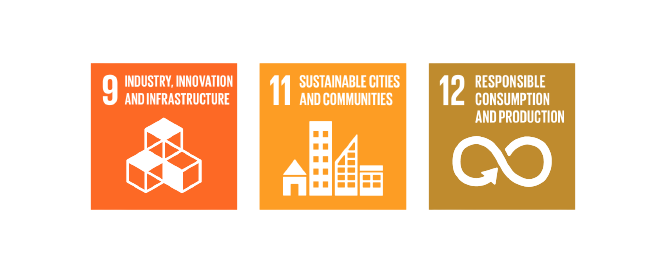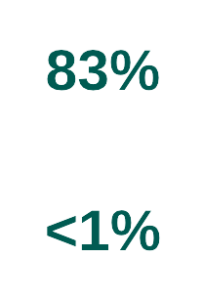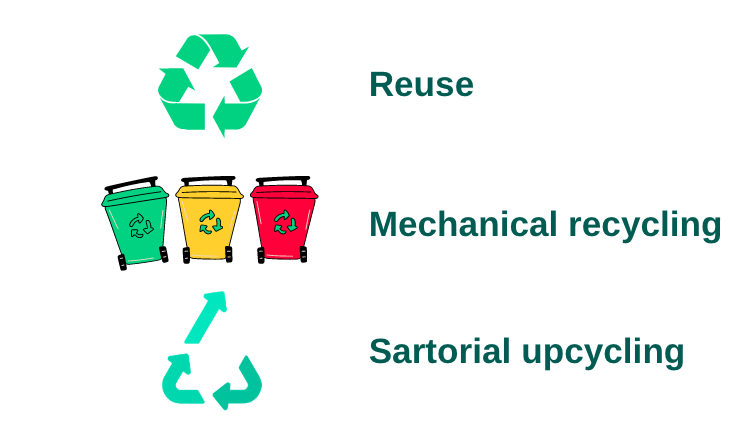Re4Circular Innovation
Our project contributes to the achievement of 3 SDGs

Less textile waste in the environment
The biggest impact is a decrease of the percentage of post-consumption used clothes that ends up in landfills or burned in incinerators, which also lowers the release of dangerous substances in the atmosphere and the following negative effect on human and environmental health. We ensure that every used garment collected is analysed with technology in order to direct it towards the most sustainable destination possible.
According to the “thredUP’s Annual Resale Report (2020)”, giving a second life to a garment reduces its impact in terms of eCO2 by 79%; the application of our model on a large scale, therefore, would lead to a drastic decline in the environmental impact of this industry.
How the system works today

Of end-of-life textile waste that ends up in landfills and is often exported to developing countries, especially in Africa and Asia.
Is recycled into new clothes and the rest is redirected to low-value utilizations like paddings, rags, insulation, that cannot be recovered after use.
Impact in the textile collection and sorting
Textile is a very complex and diversified material, of mixed composition, and there are many characteristics to detect and transmit in order to recycle or reuse it. The sorting process is usually done by hand, with high costs and waste of time. This makes the practice extremely expensive for textile waste collectors. The technology of Re4Circular allows to change this system: it is innovative and founded on the increase in efficiency and sustainability in the field, as well as the promotion of economic valorization of textile waste and its channeling towards eco-friendly uses.
A more responsible management
The positive repercussions of our solutions are relevant not only locally. Currently, 70% of textile waste produced in the EU and in the USA ends up in developing countries, especially Africa. Here they are resold at a very low price, replacing the local textile economy. The majority of clothes arriving in these countries are from “fast-fashion”, of poor quality and worn-in, and they end up flooding landfills and causing heavy environmental, social and sanitary repercussions.
Click here to find out more on the topic
Our model makes sure textile waste is handled where it is produced and doesn’t simply relocate the issue to another continent. We digitalize and shorten the process, while guaranteeing its transparency.
Moreover, our solution is consistent with the current regulatory level. In fact, following the approval of the legislative package on circular economy and waste management, all member states of the European Union must make textile waste collection mandatory by 2025 (Italy has set an earlier deadline, 2022).
Our solution also represents an opportunity on a public level, since the efficient management of textile waste reduces the public spending related to this service and the consequential environmental impact.
A more circular fashion
Another important and positive aspect of our project is related to the fashion field.
Re4Circular promotes the use of secondary raw materials (leftover fabrics/used clothes) by the textile-clothing-fashion industry, in order to avoid the extraction and use of verign resources for the production of new clothes.
The number of natural resources used every year in the textile and fashion industry is massive!
To learn more about this, see the article by the European Parliament.
With Re4Circular all players in the textile-clothing-fashion industry can access this supply:
- Companies that deal with the recycling of textile fibers;
- Second-hand shops;
- Artisans, upcyclers and refashioning brands;
Each business will have access to all the information in order to treat this secondary raw material in the most efficient way possible and create sustainable products.

Moreover, with the facilitation of textile waste recovery, we promote the valorization and development of artisanal skills and professions (like tailors, and more) that were being neglected.
Among upcyclers there are also social tailoring workshops, that include disadvantaged people through labor. Our circular and efficient model allows to simplify their tasks and the supply of secondary raw materials in order to create circular products, including these people into value chains from which it’s usually easy to be excluded from.
To sum up: our technological approach allows the adoption of economies of scale and enables even smaller companies to embrace circular and sustainable business models, as well as ensuring transparency among all players in the industry and towards the final consumer.


